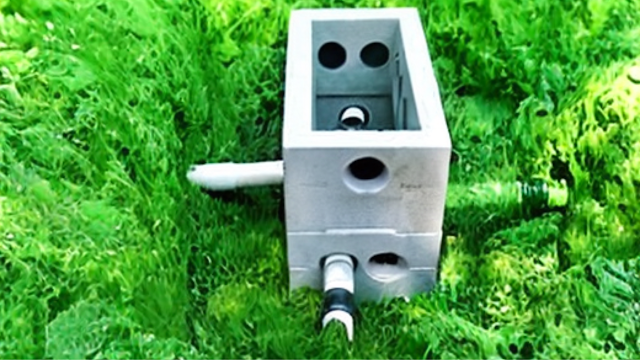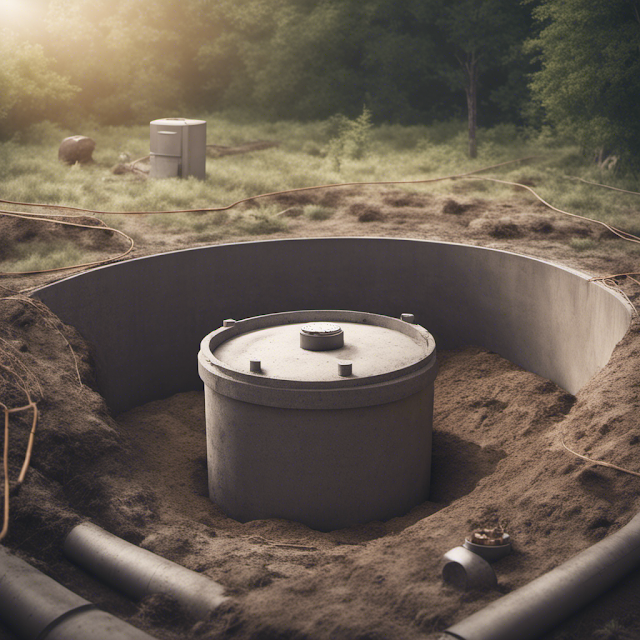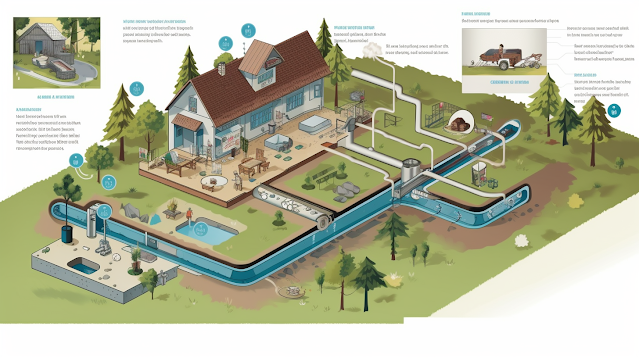Unveiling The Battle: Aerobic Vs. Anaerobic Septic Systems - Which One Wins?
 |
| Aerobic Vs. Anaerobic Septic Systems |
Are you in the market for a new septic
system but feeling overwhelmed by all the options? Look no further! In this
article, we will delve into the battle between aerobic and anaerobic septic
systems to determine which one comes out on top.
By understanding their functionality,
treatment processes, efficiency, maintenance requirements, suitability for
different soil types, durability, lifespan, and local regulations, you can make
an informed decision that meets your specific needs.
Aerobic and anaerobic septic systems both
have their merits and drawbacks. It is crucial to weigh these factors carefully
before making a choice.
With an objective and evidence-based
approach, we will compare these two systems side by side to help you navigate
through the complexities of septic system selection.
So let's dig deep into the world of
septic systems and find out which one wins this battle: aerobic or anaerobic?
Key Takeaways
•
Aerobic septic systems utilize
oxygen and beneficial bacteria for efficient waste breakdown, while anaerobic
septic systems operate without oxygen and rely on bacteria for waste breakdown.
•
Aerobic septic systems have
advantages such as higher wastewater volume handling and cleaner effluent, but
require regular maintenance and have a higher upfront cost.
•
Anaerobic septic systems have
advantages such as methane gas production and low energy consumption, but can
experience sludge accumulation and potential odor issues.
•
Factors to consider in choosing
a septic system include soil type, maintenance requirements, energy
consumption, property size, and water usage patterns.
Understanding
the Functionality of Aerobic Septic Systems
Are you curious about how aerobic septic systems work and why they
might be the better choice for your home? Let's delve into the functionality of
these systems and explore their pros and cons.
Aerobic septic systems are a modern alternative to conventional
anaerobic septic systems. They utilize an aerobic treatment unit that
introduces oxygen into the system, promoting the growth of beneficial bacteria
that break down waste more efficiently. This results in a higher level of
treatment and reduces the risk of groundwater contamination.
One advantage of aerobic septic systems is their ability to handle a
higher volume of wastewater compared to anaerobic systems. This makes them
suitable for larger households or properties with increased water usage.
Additionally, aerobic systems produce cleaner effluent, which can be reused for
irrigation purposes.
However, it's important to consider some drawbacks as well. Aerobic
septic systems require regular maintenance, including monitoring oxygen levels
and adding necessary chemicals to promote bacterial growth. This maintenance
can be time-consuming and costly compared to anaerobic septic system
maintenance.
When comparing costs, aerobic septic systems tend to have a higher
upfront cost due to their complex design and additional equipment required.
However, over time they may prove more cost-effective due to lower repair
expenses and increased efficiency.
Now that we have explored the pros and cons of aerobic septic
systems, let's transition into exploring the mechanics of anaerobic septic
systems without missing a beat.
Exploring
the Mechanics of Anaerobic Septic Systems
Exploring the Mechanics of Anaerobic Septic Systems reveals their
efficient and cost-effective functioning. These systems operate by utilizing
natural processes that occur in the absence of oxygen. Here are five key
aspects to consider:
•
Decomposition: Anaerobic septic
systems rely on bacteria to break down organic matter, such as human waste and
household wastewater, into simpler compounds. This decomposition occurs through
a series of anaerobic reactions.
•
Methane production: One
significant advantage of anaerobic systems is the generation of methane gas
during the decomposition process. This gas can be captured and used as an
energy source for heating or electricity production, providing an additional
benefit.
•
Sludge accumulation: The
anaerobic environment promotes sludge formation due to incomplete breakdown of
solid waste. Regular maintenance is required to remove this accumulated sludge
from the system to ensure proper functioning.
•
Odor control: Although some
odor may be present due to the decomposition process, anaerobic septic systems
generally produce fewer odors compared to aerobic systems. However, periodic
inspection and maintenance are necessary to prevent any potential odors from
becoming problematic.
•
Low energy consumption: Unlike
aerobic systems that require constant aeration using blowers or compressors,
anaerobic systems operate without the need for additional energy inputs. This
makes them more cost-effective in terms of electricity usage.
Transitioning into comparing treatment processes: aerobic vs.
anaerobic, it becomes clear that both types have unique advantages and
disadvantages in terms of functionality and performance.
Comparing
Treatment Processes: Aerobic vs. Anaerobic
When comparing treatment processes, it's important to understand the
unique advantages and disadvantages of aerobic and anaerobic systems.
Aerobic septic systems rely on oxygen to break down organic matter
through a process called aerobic digestion. This method is highly effective in
removing pollutants and produces cleaner effluent compared to anaerobic
systems. Additionally, aerobic systems can handle a higher volume of wastewater
and are more efficient at treating waste from large households or commercial
establishments.
On the other hand, anaerobic septic systems do not require oxygen
for their treatment process. Instead, they use bacteria that thrive in
environments without oxygen to break down organic matter. While this method is
less energy-intensive than aerobic digestion, it produces methane gas as a
byproduct which contributes to greenhouse gas emissions. Anaerobic systems are
also less efficient in treating certain types of waste, such as household
chemicals or pharmaceuticals.
In terms of maintenance, aerobic septic systems require regular
inspection and servicing to ensure proper functioning of the air compressor and
diffusers. In contrast, anaerobic septic systems have fewer mechanical
components that may require maintenance but may need periodic pumping to remove
accumulated sludge.
Transitioning into the subsequent section about assessing efficiency
and environmental impact, it's crucial to consider both the performance and
sustainability aspects of these two treatment processes.
Assessing
Efficiency and Environmental Impact
Assessing the efficiency and environmental impact of these treatment
processes reveals significant differences in their performance and
sustainability. When comparing aerobic and anaerobic septic systems, it becomes
clear that each has its own strengths and weaknesses. Here are five key factors
to consider:
•
Energy consumption: Aerobic
systems require a constant supply of electricity to power air blowers and
pumps, making them more energy-intensive compared to anaerobic systems, which
operate without electricity.
•
Treatment capacity: Anaerobic
systems have a higher treatment capacity than aerobic ones. They can handle
larger volumes of waste due to the absence of oxygen requirement, making them
suitable for households with high wastewater flow.
•
Nutrient removal: Aerobic
systems excel at removing nutrients such as nitrogen and phosphorus from
wastewater. The presence of oxygen promotes the growth of aerobic bacteria that
effectively break down these compounds.
•
Odor control: Although both
systems have mechanisms in place for odor control, aerobic systems generally
perform better in this regard. The continuous introduction of air helps prevent
foul odors associated with anaerobic decomposition.
•
Environmental impact: Anaerobic
systems produce methane gas as a byproduct, contributing to greenhouse gas
emissions. On the other hand, aerobic systems release less harmful gases into
the atmosphere.
Evaluating maintenance requirements is the next step in
understanding the battle between aerobic and anaerobic septic systems.
Evaluating
Maintenance Requirements
Considering the differences in efficiency and environmental impact,
it's important to evaluate the maintenance requirements of aerobic and
anaerobic septic systems.
Both systems require regular maintenance to ensure proper
functioning and prevent costly repairs. However, there are some notable
differences in their maintenance needs.
Aerobic septic systems typically require more frequent maintenance
compared to anaerobic systems. This is because aerobic systems rely on oxygen
for the breakdown of waste materials, which requires a constant supply of air.
Regular inspections and maintenance checks are necessary to ensure that the air
supply isn't obstructed or compromised. Additionally, aerobic systems often
require periodic addition of chemicals or enzymes to enhance the breakdown
process and maintain optimal bacterial activity.
On the other hand, anaerobic septic systems have lower maintenance
requirements. These systems operate without oxygen, relying on naturally
occurring bacteria to break down waste materials. While they still need
occasional pumping to remove accumulated solids, they generally don't require
as much attention as aerobic systems.
It's worth noting that both types of septic systems may experience
issues if not properly maintained. Neglecting regular maintenance can lead to
clogs, backups, foul odors, or even system failure. Therefore, homeowners
should adhere to recommended inspection schedules and perform necessary
maintenance tasks promptly.
Evaluating the maintenance requirements is crucial when choosing
between aerobic and anaerobic septic systems. Aerobic systems demand more
frequent attention due to their reliance on oxygen and additional chemical
additives. On the other hand, anaerobic systems have relatively lower
maintenance needs but still require periodic pumping. Transitioning into cost
considerations: aerobic vs. anaerobic systems reveals another aspect of this
battle without missing a beat.
Cost
Considerations: Aerobic vs. Anaerobic Systems
Now that we've evaluated the maintenance requirements of aerobic and
anaerobic septic systems, let's delve into another important factor to
consider: cost. When it comes to cost considerations, both aerobic and
anaerobic systems have their own advantages and disadvantages.
Firstly, let's talk about initial installation costs. Aerobic
systems tend to be more expensive upfront compared to anaerobic systems. This
is because they require additional components such as an aerator, a control
panel, and additional piping. On the other hand, anaerobic systems are simplerin design and therefore generally less expensive to install.
However, it's essential to consider long-term costs as well. In
terms of operational expenses, aerobic systems require electricity for the
aeration process. This means higher monthly energy bills compared to anaerobic
systems, which don't require any additional power.
Furthermore, when it comes to maintenance costs, aerobic systems can
be pricier due to the need for regular servicing of mechanical components like
the aerator or pumps. Anaerobic systems typically have lower maintenance
requirements since they rely on natural bacterial processes.
To summarize:
•
Aerobic system installation
costs are higher initially.
•
Aerobic systems have higher
monthly energy bills.
•
Anaerobic system maintenance
costs are generally lower.
Considering these cost factors will help you make an informed
decision while choosing between aerobic and anaerobic septic systems. Now let's
move on to determining suitability for different soil types...
Determining
Suitability for Different Soil Types
Determining the suitability of different soil types is crucial in
making an informed decision about the most appropriate septic system for your
property.
The type of soil on your land will greatly affect the performance
and effectiveness of both aerobic and anaerobic septic systems.
In general, aerobic systems tend to be more suitable for properties
with poor soil conditions such as heavy clay or high water tables. These
systems rely on oxygen-loving bacteria to break down waste, which can help
improve drainage in areas where traditional anaerobic systems may struggle.
However, it's important to note that aerobic systems require a steady supply of
electricity to operate the air pump and maintain optimal conditions for
bacterial growth.
On the other hand, anaerobic systems are better suited for
properties with well-draining soils such as sandy or loamy soils. These systems
use bacteria that thrive in low-oxygen environments to decompose waste.
Anaerobic systems are typically simpler and less expensive than their aerobic
counterparts, as they don't require constant electricity.
It's also worth considering that certain regions may have
regulations or guidelines regarding septic system suitability based on soil
types. Consulting local authorities or professionals in your area can provide
valuable insights into which system would work best for your specific soil
conditions.
Considering the importance of long-term durability and lifespan when
choosing a septic system, it's necessary to examine these factors before making
a final decision. By understanding how different soil types interact with
aerobic and anaerobic systems, you can make an informed choice that ensures
efficient waste treatment and minimizes potential issues down the line.
Examining
Long-Term Durability and Lifespan
To ensure the long-term durability and lifespan of your septic
system, it's crucial to carefully assess its suitability for different soil
types. The type of soil in which your septic system is installed can greatly
impact its performance and longevity.
Certain soil types are more conducive to aerobic systems, while
others are better suited for anaerobic systems. In aerobic septic systems,
oxygen is introduced into the wastewater treatment process, promoting the
growth of beneficial bacteria that break down organic matter more efficiently.
These systems typically perform best in well-drained soils such as sandy loam
or gravelly soils. The presence of oxygen allows for a higher level of treatment
and reduces the likelihood of clogging or failure.
On the other hand, anaerobic septic systems rely on anaerobic
bacteria to decompose waste in an oxygen-free environment. These systems can
function effectively in clayey or silty soils with lower permeability. However,
they may be prone to clogging and may require more frequent maintenance
compared to aerobic systems.
When selecting a septic system for your property, it's important to
consider not only the current soil conditions but also any potential changes
that may occur over time. Factors such as changes in groundwater levels or
nearby construction projects can impact how well your septic system performs.
Considering local regulations and permitting is another crucial
aspect when evaluating the long-term durability and lifespan of your septic
system. Local authorities often have specific guidelines regarding the
installation and maintenance of septic systems based on factors like soil type,
lot size, and proximity to water sources.
By carefully assessing soil suitability, considering potential
future changes, and adhering to local regulations, you can ensure that your
septic system remains durable and functional over its lifespan without
compromising environmental safety or violating any legal requirements.
Now let's explore how these considerations tie into understanding
local regulations and permitting when installing a new septic system.
Considering
Local Regulations and Permitting
Considering local regulations and permitting is essential to ensure
the long-term durability and functionality of your septic system while
complying with legal requirements. When it comes to installing a septic system,
each area has its own set of regulations that dictate the design, size, and
location of the system. By understanding these regulations, you can avoid
costly mistakes and potential fines.
Here are three key factors to consider:
1.
Site suitability: Local
regulations often require a site evaluation before installing a septic system.
This assessment examines soil conditions, water table levels, and proximity to
water bodies or wells. It ensures that your septic system will function
properly without posing a risk to groundwater or surface water contamination.
2.
System design: Regulations may
specify the type of septic system suitable for your area based on factors like
soil permeability or lot size. Some areas have stricter requirements for
aerobic systems due to their ability to treat wastewater more effectively than
anaerobic systems. Understanding these design specifications will help you
choose the right system for your property.
3.
Permitting process: Obtaining
permits is a crucial step in installing a septic system legally and avoiding
penalties. The permitting process typically involves submitting detailed plans,
conducting inspections at various stages of installation, and obtaining final
approval from local authorities.
By considering local regulations and permitting requirements, you
can ensure that your septic system meets all necessary criteria for long-term
durability while remaining compliant with legal obligations. Making an informed
decision about choosing the right septic system requires understanding not only
these regulatory aspects but also evaluating factors such as maintenance
requirements, cost considerations, and environmental impact.
Transitioning into the next section about making an informed
decision on choosing the right septic system...
Making an
Informed Decision: Choosing the Right Septic System
Now that you've familiarized yourself with the local regulations and
permitting process for septic systems, it's time to delve into the crucial step
of making an informed decision: choosing the right septic system for your
needs.
With so many options available, it's imperative to carefully
consider various factors before settling on a choice.
First and foremost, you should assess the size and composition of
your household. Determine the average daily water usage and estimate the
wastewater volume generated. This information will help determine whether an
aerobic or anaerobic system is more suitable.
An aerobic septic system relies on oxygen to break down organic
matter efficiently. It utilizes bacteria that thrive in oxygen-rich
environments, ensuring better decomposition of waste materials. This type of
system is generally recommended for larger households or properties with higher
water usage.
On the other hand, an anaerobic septic system operates without
oxygen, relying solely on anaerobic bacteria to break down waste. While these
systems are simpler and require less maintenance compared to their aerobic
counterparts, they are typically better suited for smaller households with
lower water usage.
Additionally, consider factors such as soil conditions, site
limitations, and maintenance requirements when making your decision. Conducting
a thorough analysis of these factors will help ensure that you choose a septic
system that aligns with both your household needs and property constraints.
Remember, selecting the right septic system is not a
one-size-fits-all endeavor; it requires careful consideration of various
factors specific to your situation. By taking into account factors such as
household size, water usage patterns, and site conditions, you can make an
informed decision that will result in an efficient and effective septic system
for years to come.
Frequently Asked
Questions
How do aerobic septic
systems work?
Aerobic
septic systems work by using oxygen to break down solid waste and remove
harmful bacteria. They rely on aeration, which introduces air into the system
through a pump or diffuser. This allows aerobic bacteria to thrive and
accelerate the decomposition process.
The
resulting effluent is cleaner and less odorous compared to anaerobic systems.
Additionally, aerobic systems require regular maintenance and electricity to
operate efficiently.
Overall,
they offer superior treatment capabilities but come with higher costs and
maintenance requirements than anaerobic systems.
What are the
advantages of anaerobic septic systems?
Anaerobic
septic systems have several advantages. Firstly, they're simpler and less
expensive to install and maintain compared to aerobic systems.
Secondly,
they require less energy to operate as they don't rely on mechanical components
or electricity.
Additionally,
anaerobic systems produce less sludge, reducing the need for frequent pumping.
Lastly,
these systems are more suitable for areas with limited space or soil conditions
that aren't conducive to aerobic treatment.
How do aerobic
and anaerobic septic systems differ in terms of treatment processes?
Aerobic
and anaerobic septic systems differ in their treatment processes. In an aerobic
system, oxygen is introduced to promote the growth of aerobic bacteria that
break down organic matter more efficiently. This process produces less odor and
requires periodic maintenance like adding air or chemicals.
On
the other hand, anaerobic systems use anaerobic bacteria that function without
oxygen, but they are slower in decomposition and produce more odor. Maintenance
involves regular pumping to remove solids.
What are the
maintenance requirements for aerobic septic systems?
To
maintain an aerobic septic system, regular maintenance is necessary. This
includes inspecting the system annually for any signs of damage or malfunction.
Additionally, the air compressor and diffuser should be checked regularly to
ensure proper functioning.
It's
important to monitor the oxygen levels in the system and adjust them if needed.
Regularly pumping out solids from the tank is also crucial to prevent clogs and
maintain efficient treatment.
Following
these maintenance requirements will help ensure optimal performance of your
aerobic septic system.
How do the costs
of aerobic and anaerobic septic systems compare?
When
comparing the costs of aerobic and anaerobic septic systems, several factors
come into play.
Aerobic
systems tend to be more expensive upfront due to their advanced technology and
additional components like air pumps and filters. However, they often have
lower long-term maintenance costs as they break down waste more efficiently.
On
the other hand, anaerobic systems have lower initial costs but can require more
frequent pumping and maintenance.
Ultimately,
the cost comparison depends on individual needs, location, and environmental
regulations. Want to find out more about other septic
Research and Fact Checked:
.png)





.png)




Comments
Post a Comment